Technical Newsletter
Issue 36
Limit Equilibrium Method (LEM)
Limit Equilibrium (LE) is not a new term but it is new to the Segmental Retaining Wall (SRW) design practice. LE is a way to describe the process of determining the global stability of a slope or wall structure. Since the inclusion of Internal Compound Stability (ICS) into the SRW design process in 2007, the entire SRW industry has looked at the inclusion of a global stability “Like” analysis as clearly the more accurate approach to determine the internal stability of a geogrid reinforced wall or even a simple gravity wall. A complete discussion of ICS can be found in the Allan Block Engineering Manual.
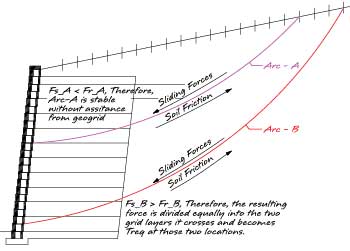
The Limit Equilibrium Method (LEM) has been developed by University Professor Dov Leshchinsky, PH.D. through years of research and was recently adopted by the Federal Highways Administration (FHWA) and the National Concrete Masonry Association (NCMA) as a viable alternative for traditional SRW Internal design calculations. Traditional internal design is based on the active earth pressure theory that has been found to be less accurate then LEM when attempting to simulate actual forces within the geogrid reinforced soil mass. The FHWA published LEM manual (FHWA –HIF-17-004)is available for download. A complete discussion of LEM can be found in the Allan Block Engineering Manual.
The main goal of LEM is to expand on the industry wide accepted ICS model and bring an even higher level of global stability analysis into the internal stability of the reinforced mass. Please note that LEM slip arcs never go below the bottom of the bottom block. That is why LEM does not replace the need for a designer to analyze the global stability of the entire hillside.
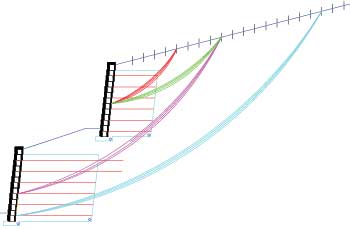
By adopting the LEM method, the SRW industry is moving towards abandoning the old, more theoretical Coulomb active earth pressure calculations for this easy to understand and highly accurate global modeling method. LEM, like ICS, uses a simplified Bishop’s Simplified Method of Slices global method to determine the forward sliding forces that need to be resisted by the geogrid layers and facing material in the form of block shear and geogrid connection capacity. The forward forces are determined simply by subtracting the Resisting Forces (Fr) along a slip arc from the Sliding forces (Fs) along that same slip arc. If the resulting forces are negative, the slip arc has no forward sliding forces and thus the slip arc is stable without geogrid or facing interaction. However, if the resulting forces are positive, there are forward sliding forces that need to be accounted for by including geogrid reinforcement layers.
Likewise, if forward sliding forces are calculated, LEM uses a detailed set of calculations to determine the pullout resistance of each geogrid layer in terms of soil pullout or connection loading at the face. The Bishop’s modeling and geogrid pullout will be covered further inside this newsletter. Lastly, since the LEM method approach is more complex or rigorous in its analysis, we believe that the area that it will be most helpful for the local engineer is when they are required to develop a more complicated multiwall geometry with slopes above the top wall and even slopes between terraces. Without an approach such as LEM it is very difficult to model the structure all at one time.
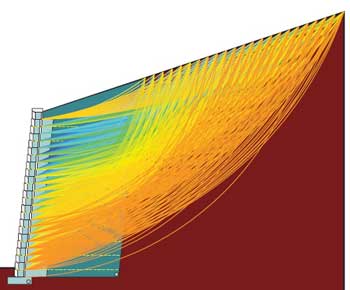
Determining the LEM Sliding Forces
LEM uses a Bishop’s Simplified Method of Slices global modeling method to determine the forward forces that need to be resisted by the geogrid layers and facing material. It is not meant to replace the need for a complete global stability analysis, but rather provides a more refined evaluation of the internal forces in the reinforced mass. For a LE Bishop’s Model to be as accurate as possible, a model must create a complete envelope of coverage, analyzing slip arcs from the extreme outer nodes to the very close nodes directly behind the face and virtually every point in between.
The Bishop’s Simplified Method of Slices is used to determine first the weight of the soil above the slip surface and then the sliding and resisting forces due to that soil weight along the slip surface. In Bishop Modeling the soil wedges can be calculated as individual parts due mainly to Bishop’s assumption that the vertical frictional forces between the soil wedges are neglected. This means that for design purposes there is no interaction between the individual soil wedges. Therefore, the individual soil wedge weight is determined simply by multiplying the volume of soil in the wedge by the unit weight of the soil. To determine the wedge volumes the designer must determine the exact geometry of the wall section and the slip arc that is to be evaluated.
After the wedge weight is determined, then the sliding force can be calculated. The sliding force is determined by the wedge weight multiplied by the angle of slope at the bottom of the wedge. By repeating this process for every wedge and summing them together the total forward sliding force is found.
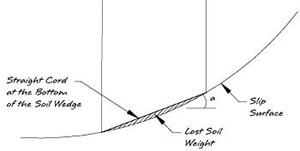
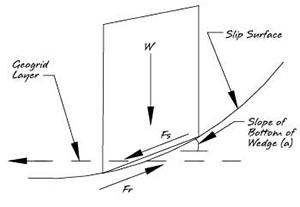
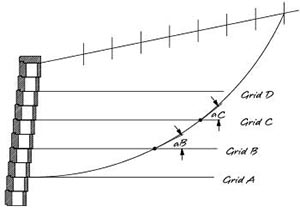
The sliding resistance force is calculated by multiplying the individual wedge weights by the tangent of the internal friction angle of soil, which is commonly used for soil frictional interaction coefficient. However, Bishop’s method then divides this term by a geometric equation that is a relationship between the strength of the soil and the relative angle at the bottom of each wedge. This relationship is more clearly defined in the complete Allan Block Engineering Manual chapter or the FHWA published report.
Once the sliding forces and the resisting forces are known the total sliding force can be calculated. This is calculated by subtracting the sum of all the resisting forces from the sum of all the sliding forces.
If the sliding forces are greater than the resisting forces the resulting total sliding force, called Treq, is then divided into each grid layer the slip arc comes in contact with. This part of the LEM processes is called the geogrid pullout calculations.
Geogrid Pullout Calculations
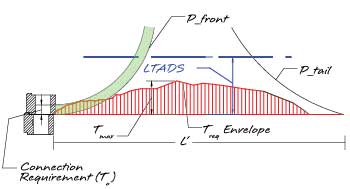
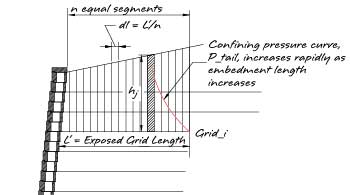
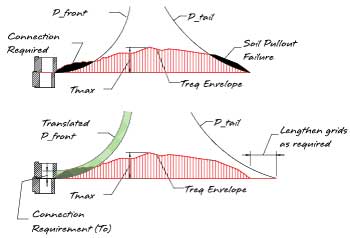
The geogrid pullout calculations in the LE Method are entirely separate from the Bishops side. The pullout envelope is calculated along each geogrid length from the front end of the grid layer defining connection requirements to the tail end defining the soil pullout requirements. The goal is to develop a pullout (P) envelope of resistance forces that entirely surrounds the Bishops calculated Treq envelope.
To determine the pullout capacity and resulting graphical curve, start by dividing the length of each grid layer into equal segments from the back of the facing to the tail of the grid. These individual segments will be used to calculate the confining pressure above that small length of grid and the sum of each sequential segment will define the front end and tail end pullout capacity curves. The tail end curve is developed by using the same soil pullout equations the SRW industry has used from the beginning. However, LEM has refined it to be used for each segment along each grid layer. By repeating the calculation for each segment the pullout resistance at each segment relative to the increasing embedment length of the grid and thus the pullout capacity can be found anywhere along the grid’s length creating a pullout of soil envelope to compare to the Treq envelope.
This analysis process is performed along each grid layer starting from the tail end of the grid, working towards the front (for pullout of soil and proper grid length determination) and then vice versa, from the front end of the grid to the tail (for determining the required facial contribution from connection and shear). When comparing the Treq results envelope from the Bishops model to the soil pullout envelope P, you may find that the Treq > P. If this is the case, you either need to lengthen the grid layer if it happens at the tail-end. You have a connection requirement if it happens at the front-end, or both. Conversely if P_front or P_tail does not intersect the Treq envelope it would indicate there is no load on the face of the structure or that the grid lengths at the back of the structure are longer than what would be required to obtain equilibrium.
This process is used for each grid layer to determine the minimum required capacities to resist the Treq sliding forces. Once these minimums are found the designer can then choose an appropriate geogrid that exceeds these minimums multiplied by a commonly used safety factor. The significance of LEM is that the calculations allows the design to create and analyze a baseline set of calculations and then determine the required block and grid characteristic to best fit the needs of the project. For a complete discussion of LEM including a detailed discussion of determining connection capacity see the Allan Block Engineering Manual.
Limit Equilibrium vs. Global Stability
Global stability modeling is used to analyze the entire hillside from top to bottom including any structures like retaining walls or buildings. LEM uses the math behind global stability modeling to develop slip arcs within the reinforced soil mass to more accurately analyze the internal stability of the mass. LEM does not eliminate the need to analyze the site for overall global stability.



